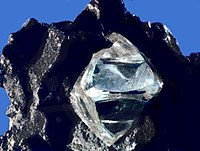
Photo from wikipedia
Low temperature heteroepitaxy of cubic silicon carbide (3C-SiC) on silicon substrates is key to the low-cost and mass scale hetergeneous integration of 3C-SiC into the semiconductor market. Low temperature growth… Click to show full abstract
Low temperature heteroepitaxy of cubic silicon carbide (3C-SiC) on silicon substrates is key to the low-cost and mass scale hetergeneous integration of 3C-SiC into the semiconductor market. Low temperature growth also opens up the opportunity to dope 3C-SiC in situ during the epitaxial growth with standard Si based n-type and p-type dopants. In situ doping offers many advantages over ion implantation, such as complex doping profiles, more abrupt interfaces and minimal crystal damage. In this study, 3C-SiC thin films have been doped with phosphorus to a range of concentrations during epitaxial growth on standard silicon (Si) substrates. Both the material and electrical properties of the films have been investigated. Hall effect measurements and secondary ion mass spectroscopy profiling confirm 100% electrically active n-type dopants up to 2 × 1020 cm−3. The process offers extreme control over the 3C-SiC electrical properties without relying on post-growth ion implantation and high temperature activation annealing, enabling the formation of more complex 3C-SiC based devices and low resistance contacts.
Journal Title: Semiconductor Science and Technology
Year Published: 2018
Link to full text (if available)
Share on Social Media: Sign Up to like & get
recommendations!